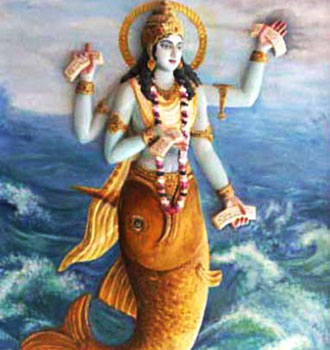 Content of Matsya Purana includes in the conversation between the Matsya avatar of Lord Vishnu and Manu. The story of the Matsya Purana begins with the king Manu, passing his days in observing "Dhyana" in his hermitage. A King of the Surya Vanshi dynasty, Manu handed over the kingdom to his son Iksvaku and went to the foothills of Malaya and performed Tapasya in order to please Lord Brahma. Pleased with his prayers Brahma appeared and gave him the holy blessing. King Manu was blessed with the power that he will be the saviour of the world when the Mahapralaya will come to destroy it.
Content of Matsya Purana includes in the conversation between the Matsya avatar of Lord Vishnu and Manu. The story of the Matsya Purana begins with the king Manu, passing his days in observing "Dhyana" in his hermitage. A King of the Surya Vanshi dynasty, Manu handed over the kingdom to his son Iksvaku and went to the foothills of Malaya and performed Tapasya in order to please Lord Brahma. Pleased with his prayers Brahma appeared and gave him the holy blessing. King Manu was blessed with the power that he will be the saviour of the world when the Mahapralaya will come to destroy it.
After the passing of several days, Manu was performing rituals in the pond near his hermitage. While he immersed his hands in the water he found a minnow swimming around in the water. Manu did not kill it but kept it in his water pot or Kamandalu. But the minnow started to grow and within a day the water pot seemed so small. The fish started growing and everywhere Manu kept it -vat, pond, river and finally the ocean- seemed too small for the fish. Surprisingly overwhelmed Manu understands that it was not a mere fish. Unsure of the fact that whether it`s a demon deluding him, Manu came to know that it was the incarnation of Lord Vishnu himself on the earth. Then the Matsya avatar of Lord Vishnu revealed the truth and told that the earth would soon be flooded with the water. Vishnu gifted Manu with a boat. When the earth was flooded, Manu placed all living beings on the boat and thus saved them from immediate destruction. Vishnu himself arrived in his form of the fish and Manu tied the boat to the fish`s horn. Thus the living beings were saved. And when the waters of the flood receded, Manu populated the world afresh.
Saving the mortals from immediate destruction, Lord Vishnu disappeared and after that there was a terrible drought for hundred years on earth. Consequently there was famine and people died out of starvation. The sun also blazed in fury. At a time everything appeared to burn into ashes. The clouds of destruction named Samvarta, Bhimananda, Drona, Chanda, Valahaka, Vidyutapataka and Kona appeared on the sky. Again the rain began to pour from the water engulfed the entire earth. Then Manu again saved the living beings gathering them into the boat as instructed by Lord Vishnu. When the fish appeared, Manu tied the boat to the fish`s horn with a gigantic snake. While the boat was thus dragged around by the fish, Manu asked Vishnu several questions. The answer provided by the Matsya, formed the text of the Matsya Purana.
During this session of conversation Vishnu imparted to Manu, the Surya Vanshi king, the knowledge of the mystery of creation, destruction and recreation, the various eras in universe, knowledge about the solar and the lunar dynasties and the royal genealogies. Thus Manu achieved the wisdom that Divinity is eternal.
In the Matsya Purana, Creation is treated in detail, then follow the genealogies, into which is inserted a section about the Fathers and their cult (Chapters 14-22). The usual geographical, astronomical and chronological sections are also found as in the case of the other Puranas. Moreover, the lists of the kings in this Purana are held to be particularly reliable by most scholars. The lists of kings in this Purana are particularly reliable for the Andhra dynasty.
It has very much in common with the Mahabharata and the Harivamsa Parva - the legends of Yayati (Chapters 24-43), Savitri (Chapters 208-214), the incarnations of Vishnu (Chapters 161-179, 244-248); and there is often literal agreement. There are, however, very numerous later additions and interpolations. For instance we find a considerable section about all manner of festivals and rites (Vratas, Chapters 54-102), a glorification of the sacred places of Allahabad (Prayagamahatmya, Chapters103-112), Benares (Varanasi and Avimuktamahatmya, Chapters 180-185), and of the Narmada River (Chapters186-194); then sections on the duties of a king (Chapters 215-227), on Omina and Portenta (Chapters 228-238), ceremonies at the building of a house (Chapters 252-257), the erection and dedication of statues of deities, temples and palaces (Chapters 258-270), the sixteen kinds of pious donations (Chapters 274-289), etc.
As far as the religious content is concerned, the Matsya-Purana might be called Shaivaite with just as much reason as it is classed as Vishnuite. Religious festivals of the Vaisnavas are described side by side with those of the Saivas, and both Vishnu and Shiva legend are related. In Chapter 13 Devi ("the Goddess," Shiva`s wife Gauri) enumerates to Daksha the one hundred and eight names by which she wishes to be glorified. Thus it is seen that both sects used the work as a sacred book.












